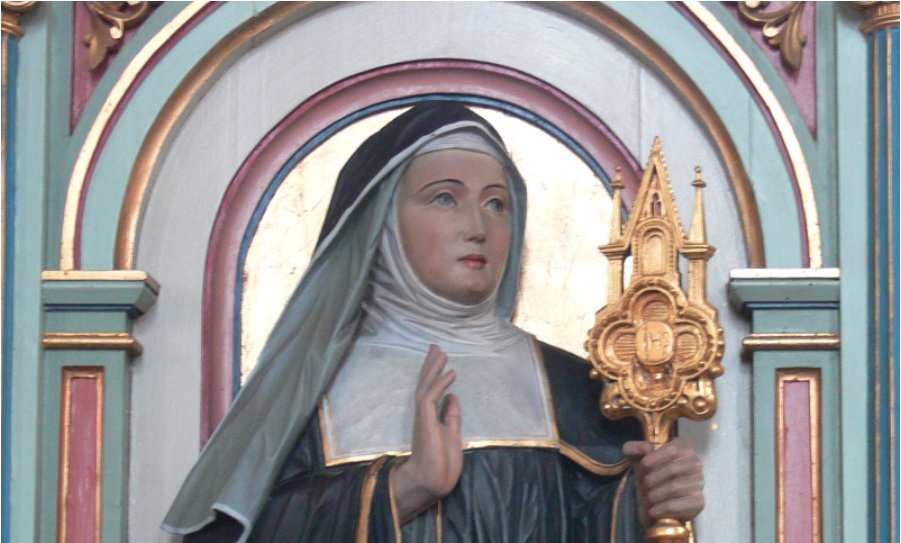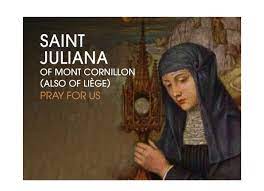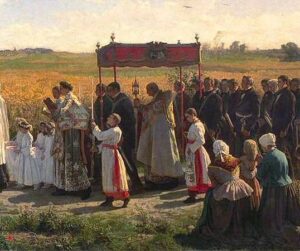
St. Juliana of Liège was a religious and an anchoress who is largely responsible for the worldwide Catholic feast of Corpus Christi. Juliana was born at Retinnes, near Liège in what then the Holy Roman Empire, now in eastern Belgium, in 1192. She was orphaned at age five and placed in a Norbertine monastery. The Norbertines were a branch of the Augustinian Order. This double monastery – men in one section and women in the other – also owned a working farm where Juliana was taken. It was located just outside of Liège at Mount Cornillon. From her most tender childhood years, Juliana loved to spend time in front of the Blessed Sacrament. She devoted herself to read the writings of the Fathers of the Church in Latin, especially those of Sts. Augustine and Bernard of Clairvaux, and she steadily grew in virtue. She joined the order as a nun at age thirteen. The monastery operated a hospice or hospital for leprosy patients, and this is where Juliana spent most of her time, tending to the needs of the patients.
MYSTERIOUS VISIONS
When she was sixteen, Juliana began having visions while in Adoration. She repeatedly saw a bright full moon, but with a dark blemish or stripe, which marred its beauty. She believed that there was not a proper veneration of the Blessed Sacrament, because the one time Its institution appears in the Mass readings is Holy Thursday, which left this monumental event overshadowed by the events of the Sacred Triduum. At some point, the Lord made it known to her that the beautiful moon symbolized the liturgical life of the Church and the dark blemish symbolized the need for a special feast in honor of the Eucharist, Jesus’s Body and Blood offered to us. She kept this revelation quiet, knowing that a nun was hardly in a position to affect the Church’s liturgical feasts. She only shared this information with an anchoress who had become a close friend, [Blessed] Eve of Liège. In 1225, Juliana was elected abbess of the double monastery. She then shared her visions and revelation with her confessor, Canon John of Lausanne. It was he who indeed had influential contacts, including the Bishop of Liège, the Dominican Provincial of France, and Jacques Pantaleon of Troyes, the Archdeacon of Liège. When these men gathered, they decreed that there was nothing contrary to the Faith in this private revelation, and gave their consent that this feast be established. Together Canon John and Juliana composed the first office or chant for Corpus Christi, the Body of Christ.

PERSECUTION
As abbess, Juliana set about to reform the monasteries to the true Augustinian Rule from which they had strayed. Thus began a time of painful persecution and turmoil that characterized much of her remaining years. The layman who oversaw the monasteries and hospital was a corrupt scoundrel who bought the position through bribery. He made false accusations repeatedly, driving Juliana to flee to the cell of her friend Eve. The Bishop of Liège cleared her good name in court and restored her to her monastery, while her tormentor was ousted. In 1246, the Bishop established the feast of Corpus Christi on the Thursday following the Octave of Holy Trinity for his diocese. After his death in 1247, the new bishop again placed Juliana’s tormentor as her overseer, and she was driven permanently from the monastery. She found refuge with the Cistercians at Salzinnes at Namur, but again had to flee when the monastery was burned to the ground by soldiers of Henry II of Luxembourg. She found her final home with the Cistercians at Fosse-la-Ville, where she lived in seclusion as an anchoress until her death. She died while in Eucharistic Adoration on April 5, 1258 at age sixty-four.
CORPUS CHRISTI UNIVERSALLY ESTABLISHED

After Juliana’s death, her great friend Eve carried on her great passion for the establishment of a universal feast of Corpus Christi in honor of the Blessed Sacrament. The former Archdeacon of Liège, Jacques Pantaleon, had subsequently become a bishop and the Latin Patriarch of Jerusalem. He was elected Pope in 1261 and took the name Urban IV. As Pope, he instituted the Solemnity of the Most Holy Body and Blood of Christ for all of the Latin Church in 1264, setting it to be celebrated on the Thursday after Pentecost. It is now known by its Latin name, Corpus Christi. Urban also commissioned his lead theologian, [St.] Thomas Aquinas, to compose text for the Office and the Mass for this solemnity. He did so, giving the Church the theological masterpieces of Sacris Solemnis, which includes Panis Angelicus; and Pange Lingua, which includes Tantum Ergo Sacramentum. In his teachings, St. Thomas gave the Church the first formal use of the term transubstantiation, which accurately describes how the elements of bread and wine are completely changed in substance to the Body and Blood of Christ and are no longer bread and wine, having only their appearance. It was St. Juliana’s great friend Eve who wrote her biography. It was not because of the private revelation she received that she was canonized in 1869, but due to her heroic virtue throughout her life. Also known as St. Juliana of Mount Cornillon, St. Juliana of Liège’s feast day is April 6, and she is a patroness for Eucharistic devotion.
